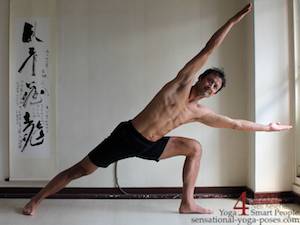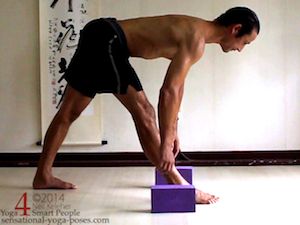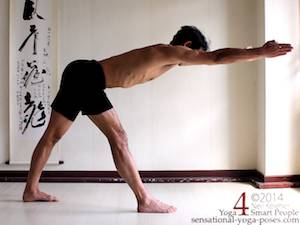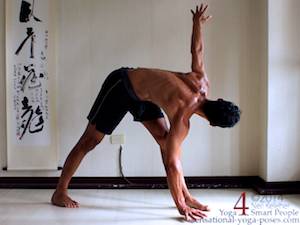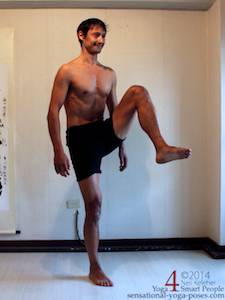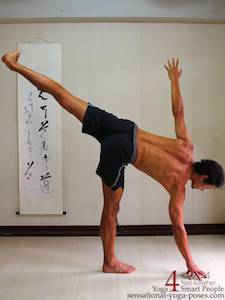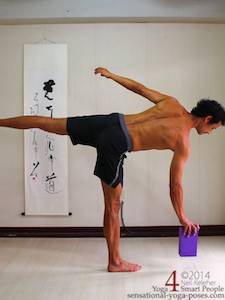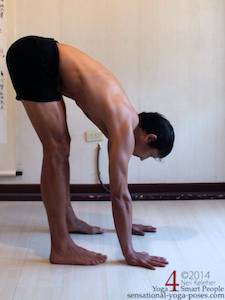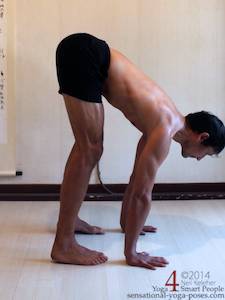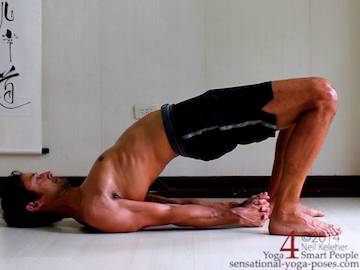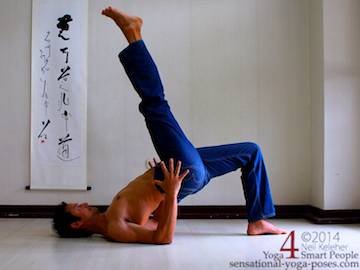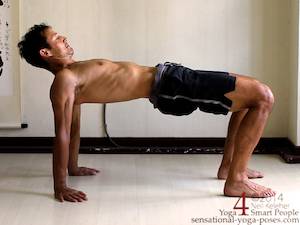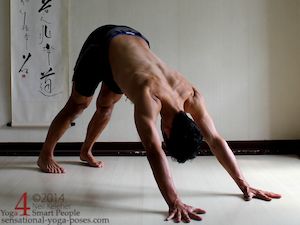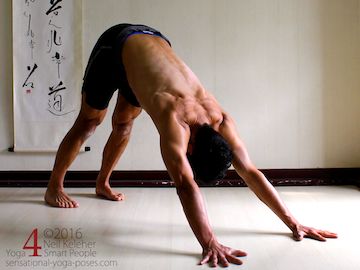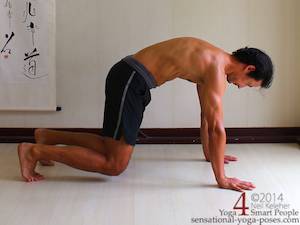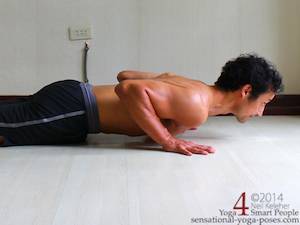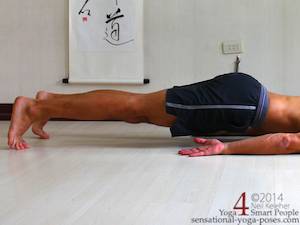Yoga Exercises to Improve Stability
Stability exercises for the Shoulders, Waist, Hips and Legs
On page cat links
Balancing on one foot, Bridge pose, Chaturanga dandasana, Dog pose, Downward facing dog, Half moon, Plank pose, Pyramid pose, Shoulder stability, Side angle pose, Table top, Triangle pose
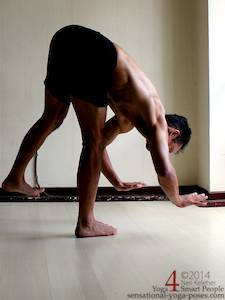
Before talking about exercises to improve stability it can help to understand what stability actually is.
Defining Stability
One way to define stability is that it is the ability to resist change.
When builders build a building, the first thing they do (assuming plans have already been drawn up) is lay a foundation. The foundation gives the building the ability to resist change. The bigger the changes that it has to resist, the more stable it's foundation has to be. The structure of the building is important also, but at the base of the structure is the foundation.
Stability in Moving Systems
In aviation, stability has a slightly different definition, and this applies to dynamic or moving systems in general. It's the tendency of a system to return to some desired state after a perturbation. (Perturbation is another way of saying "change".)
If an aircraft experiences a surge of wind while flying, then an aircraft with greater inherent stability will return to it's course with no pilot input, or will not be put of course by the change in wind in the first place. A less stable plane would require pilot input to stay on course.
When Stability Becomes a Part of Control
There's a trade off for stability. Planes that are inherently stable are also sluggish. It takes a while for them to respond to pilot input. So there is a cost for stability. And so a fighter jet, where agility is a requirement, would be designed with less inherent stability so that they can be more responsive. As a result, the pilot has to act, has to control the craft to keep it on course.
With a less stable (more agile) aircraft, the pilot has to make control inputs not only to change course, but also to keep the plane on course. And so stability is a subset of control.
Stability in Yoga
In yoga both definitions of stability can be useful.
Doing a yoga pose, which is basically static, we can use the first definition of stability, resist change, keep the body still. But one area where the idea of dynamic stability may be applicable is while doing yoga is breath work. Does your breathing change when subjected to heavier loads? If so, you're breathing isn't very stable.
In both cases, there is an element of control. We can control muscles to make our body more more less resistant to change. We can control our respiratory muscles to keep our breath stable even under changing effort loads.
In either case, the more aware we are, both of the changes outside of our body, and the changes inside of it, the easier it is to stay stable.
Creating Joint Stability
One of the most basic ways to create stability is to use opposing muscles against each other to stiffen and stabilize a joint.
The idea here is not to exert as much tension as possible but to use the amount of tension that is just right for the task at hand.
Why? Because the more tension that we exert the more we impair sensitivity, awareness and adjustability. Plus it uses more effort than when just the right amount of tension is used.
Plus the ability to vary the amount of tension, from too little, to too much, leads to better control of the body, the chance to make fine adjustments or the chance to control movement so that it is slow, smooth and gradual if that is desired.
Stability from Muscle Working Against Gravity
Another way that stability can be created is to use muscle power against the force of gravity. In this case, instead of muscles working against each other, a set of muscles works against the weight of the body part it is supporting.
Those muscles are then working against the change that gravity tries to create as it pulls the body down.
Turning Yoga Poses into Stability Exercises
When doing a yoga pose we can liken the body a little to a building. The part of our body in contact with the floor (and the part of the body between it and the bodies center of gravity) can be thought of as the foundation. However, a major obvious difference is that the body can move while buildings tend to not move. We can shift foundations.
One important idea here is that to shift foundations smoothly, a part of our body can be touching the floor but not be bearing any weight. That part of the body could be lifted. Or it could be used as a foundation. It all depends on how the rest of the body is positioned and also on how the body is stabilized.
This is best understood by experiencing it. And that's the purpose of the yoga pose exercises below.
Improving Leg Stability in Triangle and Side Angle Pose
In yoga poses like triangle pose and side angle pose the arm or hand is often placed on the floor, a yoga block or the lower leg. It then helps to support the weight of the upper body. However, if that arm is lifted then the legs, pelvis and the abs on the uppermost side of the body then have to work against gravity to support the upper body.
To lift the arm, the legs have to be activated, "stabilized" first. The arm can then relax and be lifted.
To make the legs stronger, more stable, you can reach the arms to the side. The legs then have to do even more work to support the weight of the body. (The moment arm is increased!)
If you note the sensation in the legs while lifting the arms and reaching them, you can duplicate this sensation with the hand on the floor. With the hand pressing into the floor to help support some body weight your legs can relax a little. So that the arm can relax so that you can lift it, brace the legs by creating the same feeling in them as when the arm was lifted. Then lift the arm and reach it.
This can take a little bit of practice so simply repeat the actions.
- Brace the leg and feel the arm relax.
- Then lift the hand and reach it.
- Then put the hand down, lightly.
- Then brace it so that the legs can relax a little.
To work on breath control at the same time, (to make your breath more resistant to change) coordinate your movements with your breath.
Leg Stability in Pyramid pose and twisting triangle
The same basic stabilizing technique can be used in yoga Poses like Triangle Forward Bend and Revolved (twisted) Triangle.
In Triangle Forward Bend (or Pyramid pose) Brace the legs so that your hands relax. Then lift them, and optionally reach them forwards.
In Revolved triangle, brace the legs to lift the bottom arm.
Note that lifting the arms are changes. Making the legs stable is a way of resisting the forces that occur as a result of these changes.
Stability In Balancing One One Leg Yoga Poses
Creating stability while standing on one leg generally requires more effort than when on two legs. When standing on one leg you not only have keep your center of gravity over a smaller area to stay balanced, you also have to work to stabilize against rotation.
A pose like Bending Forwards with One Leg Lifted is a good way to practice stabilizing not just the foot and ankle but also the hip and the knee.
Note that in this pose, the lifted leg is pulled forwards, beneath the hips, as opposed to reaching back.
This shifts the bodies center of gravity forwards, meaning that with respect to the foundation the hips have to move back. And that means more work for the buttocks and hamstrings of the supporting leg as well as the deeper hip muscles like the obturator internus.
As a way to test your ability to resist change and improve stability you can practice lifting the hands in this pose also.
An exercise like Standing Knee Lift while balancing on one foot can be used to educate the psoas and other hip flexors of the lifted leg. In this case these muscles work against the weight of the leg.
To increase the weight the hip flexors work against, reduce the bend in the knee.
Half Moon
Another exercise to improve stability is based on half moon yoga pose.
This pose can be challenging because the supporting foot is turned out relative to the pelvis. This puts the supporting leg hip near its bony limits. This can affect the ability to control the knee, ankle and foot.
This is a pose where muscles can work against each other as well as against body weight to create stability.
Note that the hip muscles of the lifted leg work against the weight of the leg to keep the leg lifted.
As before, to further exercise and improve stability try lifting the hand.
Shoulder Stability when Weight Shifting in Standing Forward Bend
One of the ways to visit shoulder stability while standing is to shift weight forwards onto the hands while doing a standing forward bend. (If you can't reach the floor you can bend your knees or place your hands on the edge of sturdy chair.)
The more you shift forwards the more you have to use the hands to help support the weight of the body. In this case the muscles that move the scapulae relative to the ribcage can be resisting the movements of the ribcage towards the floor.
The arm muscles can be working against each other to stabilize the arms. In general what you should feel as you rock forwards is some change in arm tension and arm effort. Your arms and shoulders will have to turn on in order to support your body.
Creating leg and shoulder stability in bridge pose
In a laying down posture like bridge pose where the legs are used to lift the hips, the leg muscles at the back of the legs, particularly the glute max, work against the weight of the pelvis, thighs and the lower part of the upper body to keep the pelvis lifted. The shoulders can also be used to press the ribcage upwards by pressing the shoulder blades down into the floor. The action actually used in this case is shoulder blade retraction.
One way to increase the work load in this stability exericse is to lift one leg. The supporting leg then has to double the work. To work on both hip and waist stability focus on lifting the lifted side of the pelvis also.
Creating leg and shoulder stability in table top pose
In a pose like table top you can use a similiar action, retraction of the shoulder blades, to lift the ribcage higher.
In this pose you can try lifting one arm or one leg in order to practice stabilizing the supporting leg or shoulder. In the case of lifting one arm the challenge can be to keep the supporting side shoulder blade retracted.
Elbow and Shoulder Stability in Downward Facing Dog and Plank Pose
In a semi inverted posture like downward facing dog stabilizing effort can again focus on the shoulder blades. In this case you can use the muscles that work between the shoulder blades and ribcage to push the ribcage away from the hands.
In downward facing dog and other straight elbow poses like plank pose, you could also pay attention to the elbows and help create arm stability by making the elbows stable.
The shoulders will move closer to the ears as a result. Or you could focus on widening the bottom tips of the shoulder blades while pulling the inner edges of the shoulder blades away from the head. This supraversion of the shoulder socket may also cause the ribcage to move away from the hands but will also result in the shoulders moving outwards.
Creating stability in dog pose
In a pose like dog pose you can use the leg muscles to lift the knees by pressing the fronts of the feet into the floor. This same action can be used to lift the knee in a high or low lunge.
You can also use the scapular stabilizers to lift the ribcage relative to the shoulders and keep it lifted so that the serratus anterior muscles are working against the weight of the upper body (and gravity.)
With knees lifted you can lift one hand or one knee to work on the stability of the supporting hand, leg and/or hip.
Practicing stability when lifting into Chaturanga Dandasana
In a beginners variation of chaturanga dandasana you can gradually increase the stabilizing ability of the arms with elbows bent by lifting only the ribcage (and not the pelvis), then lifting the pelvis and ribcage but not the knees, then by lifting ribcage, pelvis and knees.
A variation of this is to keep the chest on the floor and press the knees down to lift the pelvis then press the feet down to lift the knees.
For more exercises for improving midsection stability see the yoga poses for abs page.
Also see the transverse abdominis page.
Published: 2015 02 21
Updated: 2023 03 25


